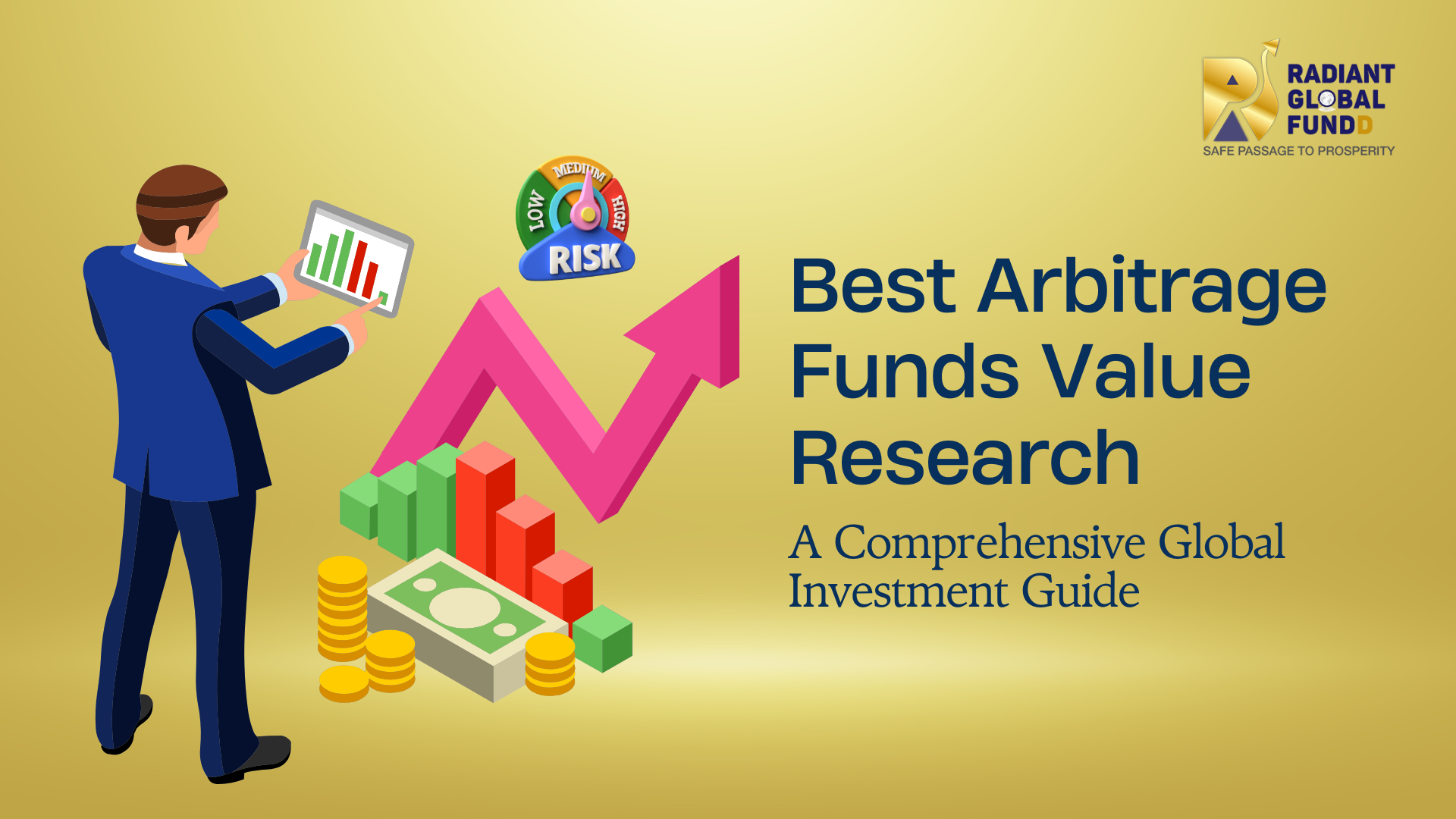
Best Arbitrage Funds Value Research
In the world of sophisticated investing, arbitrage funds have become an essential asset class for institutional and high-net-worth investors seeking low-risk, market-neutral returns. These funds leverage price inefficiencies across various markets to generate consistent profits, making them a compelling choice for those looking to navigate financial markets with precision.
This in-depth Best Arbitrage Funds Value Research explores the mechanisms, benefits, and top-performing arbitrage funds in the global market, helping you make informed investment decisions.
Understanding Arbitrage Funds
Arbitrage funds are specialized investment vehicles that capitalize on short-term price discrepancies across financial instruments. By engaging in simultaneous buy and sell transactions in different markets, these funds generate risk-adjusted returns independent of overall market movements.
How Arbitrage Funds Work
Arbitrage funds capitalize on inefficiencies in financial markets by exploiting price discrepancies across different asset classes, including equities, derivatives, commodities, and even cryptocurrencies. These funds rely on sophisticated trading strategies and advanced algorithms to identify and execute profitable trades while minimizing risks.
Identifying Price Gaps
The core principle behind arbitrage is recognizing temporary mispricings in the market. These discrepancies can arise due to various factors such as:
Market inefficiencies - Differences in supply and demand dynamics across exchanges or geographies.
Time delays - Variations in execution speed between different trading platforms.
Liquidity mismatches - Differences in bid-ask spreads across markets.
Corporate actions - Events like mergers, acquisitions, stock splits, and dividend announcements that create valuation inconsistencies.
Fund managers use quantitative models, statistical arbitrage, and real-time market data to detect opportunities before they disappear.
Executing Trades
Once an arbitrage opportunity is identified, the fund swiftly executes trades to capture the price differential. The process involves:
Buying securities in undervalued markets - Purchasing an asset where the price is lower.
Selling in overvalued markets - Simultaneously offloading the asset in a different market where it is priced higher.
Leveraging multiple trading venues - Utilizing various exchanges and trading platforms to take advantage of inefficiencies.
High-frequency trading (HFT) - Many arbitrage funds use algorithmic trading to execute transactions within milliseconds, ensuring they capitalize on fleeting opportunities.
The speed and efficiency of execution are critical, as arbitrage opportunities often vanish quickly once the market corrects itself.
Capturing Profits
The difference between the buying and selling price after accounting for costs such as brokerage fees, transaction costs, and taxes determines the investor’s return. Some key factors influencing profitability include:
Trading costs - High fees can erode arbitrage gains.
Market liquidity - Low liquidity may prevent efficient execution of trades.
Regulatory constraints - Cross-border arbitrage opportunities may be limited by capital controls or regulatory restrictions.
Arbitrage funds aim for consistent, low-risk returns rather than speculative profits.
Market-Neutral Strategy
Unlike traditional equity funds that are exposed to market trends, arbitrage funds follow a market-neutral approach, meaning their returns are independent of overall market movements. This makes them particularly attractive during periods of high volatility, as they provide a hedge against market downturns.
By maintaining balanced long and short positions, arbitrage funds reduce exposure to systemic risks, offering investors a stable and low-risk alternative in their portfolio.
Key Factors Driving Arbitrage Fund Performance
Arbitrage funds generate returns by capitalizing on price inefficiencies across markets, but their success depends on multiple factors that influence execution, profitability, and risk management.
1. Market Volatility & Liquidity
Volatility Creates More Opportunities - Arbitrage funds thrive in volatile market conditions where price disparities between securities, derivatives, or asset classes occur more frequently. Sudden price movements caused by earnings announcements, geopolitical events, or macroeconomic data releases create arbitrage opportunities.
Liquidity Ensures Efficient Execution - Higher liquidity enables arbitrageurs to enter and exit positions seamlessly, reducing the risk of price slippage. Markets with deep liquidity allow for smoother trade execution, minimizing bid-ask spreads and optimizing arbitrage returns.
Impact of Market Sentiment - In periods of extreme fear or euphoria, inefficiencies widen, but liquidity constraints can also emerge, requiring arbitrage funds to adapt their strategies dynamically.
2. Regulatory & Tax Considerations
Diverse Regulatory Landscapes - Different financial jurisdictions have unique regulations governing arbitrage strategies, affecting trade execution and capital flows. Cross-border arbitrage may face restrictions due to capital controls, transaction taxes, or reporting requirements.
Tax Efficiency Impacts Net Returns - Some regions offer tax advantages for arbitrage funds, significantly influencing post-tax profitability. Offshore jurisdictions like Mauritius provide tax-efficient investment structures, making them attractive for global investors seeking regulatory stability.
Changes in Financial Regulation - New policies such as transaction taxes, short-selling bans, or restrictions on high-frequency trading can impact arbitrage profitability. Funds must stay ahead of evolving compliance requirements.
3. Technology & Algorithmic Trading
Rise of Quantitative Finance - The integration of AI, machine learning, and statistical models enhances arbitrage efficiency by identifying opportunities with greater precision.
High-Frequency Trading (HFT) - Automated trading systems analyze market movements in milliseconds, allowing arbitrage funds to exploit fleeting price discrepancies before they disappear.
Infrastructure & Latency Management - Firms with superior computational power and low-latency execution infrastructure gain a competitive edge in detecting and executing arbitrage trades faster than their peers.
Role of Alternative Data - Advanced arbitrage strategies incorporate alternative data sources such as satellite imagery, social media sentiment analysis, and order book analytics to anticipate pricing inefficiencies ahead of traditional traders.
4. Macroeconomic & Geopolitical Influences
Interest Rate Differentials - Central bank policies and interest rate changes impact arbitrage strategies, particularly in fixed-income and currency markets. Yield curve shifts create opportunities in bond arbitrage, while carry trades benefit from differences in borrowing costs.
Currency Fluctuations & Global Trade - Exchange rate movements influence arbitrage opportunities in forex markets. Economic disruptions such as trade sanctions, inflationary pressures, or supply chain constraints affect asset prices, creating cross-border arbitrage openings.
Geopolitical Events & Market Disruptions - Political instability, elections, and international conflicts can cause short-term mispricings in equities, commodities, and derivatives. Investors monitoring macro trends can leverage event-driven arbitrage to capture asymmetric risk-reward scenarios.
By understanding these driving forces, arbitrage funds can refine their strategies, optimize risk-adjusted returns, and maintain an edge in increasingly sophisticated global markets.
Why Invest in Arbitrage Funds?
Arbitrage funds offer a unique investment approach that focuses on market inefficiencies rather than directional bets on asset prices. This makes them an attractive option for investors seeking low-risk, stable returns in various market conditions. Here are the key reasons why arbitrage funds should be a part of a well-balanced portfolio:
1. Market-Neutral Strategy
Protection from Market Swings - Unlike traditional equity funds, which are exposed to market trends, arbitrage funds operate independently of broader market movements. This makes them resilient during market downturns, corrections, or prolonged periods of uncertainty.
Hedging Against Volatility - Since these funds simultaneously buy and sell equivalent securities in different markets, they neutralize market risk. Investors benefit from predictable returns without the fear of major losses during market crashes.
Appeal During Bear Markets - In times of economic stress, when stock markets decline, arbitrage strategies remain effective as mispricings tend to increase, creating more opportunities for profits.
2. Diversification Benefits
Multi-Asset Class Exposure - Arbitrage funds invest across equities, derivatives, fixed income, commodities, and currencies, reducing reliance on any single asset class.
Global Investment Reach - Many arbitrage strategies capitalize on inefficiencies across different geographical markets, offering international diversification. This exposure reduces risks associated with regional economic slowdowns or political instability.
Low Correlation with Traditional Assets - Since arbitrage strategies generate returns from price inefficiencies rather than macroeconomic trends, their correlation with traditional stock and bond markets is minimal. This makes them a valuable hedge within a broader investment portfolio.
3. Liquidity and Flexibility
Higher Liquidity vs. Hedge Funds - Unlike many hedge funds that impose lock-in periods or redemption restrictions, arbitrage funds often offer greater liquidity, allowing investors to enter and exit positions more easily.
Attractive for Institutional and High-Net-Worth Investors - Large investors favor arbitrage funds due to their capital preservation, predictable returns, and risk-mitigating nature, making them an ideal choice for wealth management and portfolio stabilization.
Short-Term and Long-Term Investment Potential - While some arbitrage trades are executed within minutes (high-frequency trading), others such as merger arbitrage play out over months, allowing funds to cater to different investment horizons.
4. Tax Efficiency in Offshore Jurisdictions
Optimized After-Tax Returns - For global investors, arbitrage funds domiciled in tax-efficient jurisdictions like Mauritius offer substantial tax benefits, ensuring higher net returns.
Regulatory and Legal Advantages - Offshore structures provide a stable and business-friendly regulatory environment, enabling fund managers to execute arbitrage trades across multiple regions with fewer restrictions.
Enhanced Capital Mobility - By operating from strategic financial hubs, arbitrage funds can efficiently manage cross-border trades, currency conversions, and taxation complexities, making them highly attractive to global investors.
Types of Arbitrage Strategies
Arbitrage funds employ various strategies to exploit price inefficiencies across different asset classes and markets. Each approach is designed to generate risk-adjusted returns by taking advantage of temporary mispricings. Here are some of the most commonly used arbitrage strategies:
1. Merger Arbitrage
Merger arbitrage, also known as risk arbitrage, involves investing in companies undergoing mergers, acquisitions, or other corporate restructuring events. The strategy typically involves:
Buying shares of the target company (which is being acquired) at a discount to the acquisition price.
Shorting shares of the acquiring company if the deal involves stock-based payments.
Since mergers can sometimes fall apart due to regulatory hurdles or shareholder resistance, merger arbitrage funds assess deal risks and spreads carefully before making investments.
2. Convertible Bond Arbitrage
This strategy focuses on convertible bonds, which are fixed-income securities that can be converted into the issuing company's stock. Arbitrageurs take advantage of pricing inefficiencies by:
Buying the convertible bond when it is undervalued relative to the stock.
Shorting the underlying equity to hedge against market movements.
The fund profits from changes in volatility, interest rates, and the bond’s conversion value, regardless of broader market conditions.
3. Statistical Arbitrage
Statistical arbitrage (Stat Arb) uses quantitative models and algorithmic trading to identify price discrepancies across assets based on historical price relationships. Key elements of this strategy include:
Pair trading, where two correlated securities are traded against each other, going long on the undervalued asset and short on the overvalued one.
Mean reversion analysis, where assets that deviate from their historical price patterns are expected to revert to the mean over time.
Since this strategy relies on vast amounts of data and real-time execution, it is often implemented using high-frequency trading (HFT) algorithms.
4. Cryptocurrency Arbitrage
The highly fragmented and volatile nature of cryptocurrency markets creates significant arbitrage opportunities. Traders exploit price differences across exchanges by:
Buying a cryptocurrency on an exchange where it is undervalued and selling it simultaneously on another exchange where it is trading at a premium.
Engaging in triangular arbitrage, where three different cryptocurrency pairs are traded to exploit exchange rate discrepancies.
Regulatory differences, liquidity constraints, and withdrawal fees can impact the profitability of cryptocurrency arbitrage, making execution speed a crucial factor.
5. Cross-Border Arbitrage
Cross-border arbitrage takes advantage of regulatory, tax, and economic differences between international financial markets. Some key areas where this strategy is applied include:
Interest rate differentials, where investors borrow in low-interest-rate countries and invest in higher-yielding assets elsewhere (carry trade).
Stock price discrepancies, where dual-listed companies trade at different valuations on separate exchanges.
Regulatory arbitrage, where financial instruments are structured to benefit from more favorable regulations in certain jurisdictions.
This strategy requires a deep understanding of global financial markets, trade restrictions, and currency risks.
Fund Performance & Track Record - Analyze past returns over multiple market cycles.
Expense Ratio & Fees - Consider costs, as arbitrage strategies often require high-frequency trading.
Fund Size & Liquidity - Larger AUM funds may have higher stability, but smaller funds can be more nimble.
Expertise of Fund Managers - The ability to identify and execute arbitrage opportunities efficiently is key.
Geographical Diversification - Investing in funds with a global focus can reduce localized market risks.
Key Takeaways for Global Investors
Arbitrage funds offer low-risk, steady returns irrespective of market conditions.
Choosing the right offshore fund can optimize tax efficiency and enhance portfolio resilience.
Radiant Global Fund stands out as a top-tier arbitrage investment option for institutional investors in Dubai and beyond.
Understanding the different types of arbitrage helps tailor investment strategies to suit individual risk profiles.
For expert insights and personalized investment solutions, visit Radiant Global Fund today!






